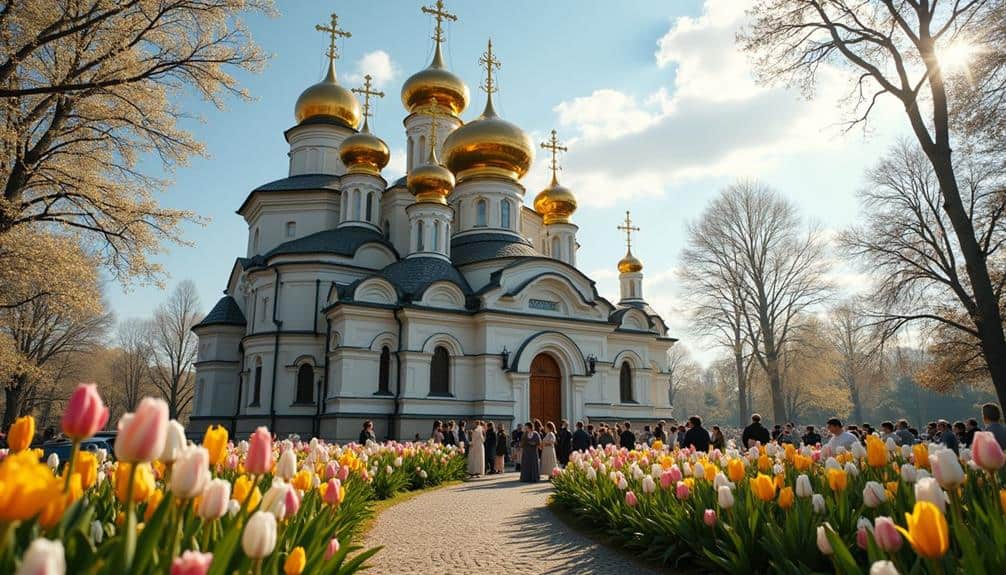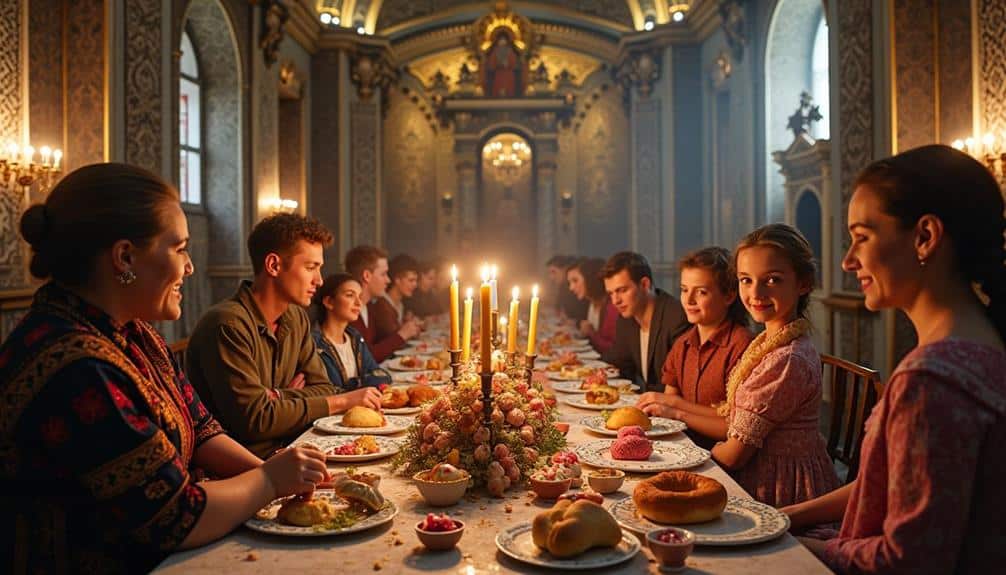As you explore Russia’s Orthodox Easter, you’ll uncover a celebration rich in history and tradition. This holiday, steeped in early Christian roots, isn’t just about marking the resurrection of Jesus Christ but also embracing a myriad of customs that bring families and communities together. From the midnight Paschal Vigil to the baking of kulich and the decorating of pysanky eggs, every aspect is designed to foster a sense of spiritual renewal and cultural heritage. Imagine the echo of “Christ is risen!” resonating through homes and churches, and you’ll begin to see why this occasion is so deeply cherished. But what truly sets it apart?
Historical Background

The historical background of Russia’s Orthodox Easter is deeply rooted in the nation’s rich religious traditions and cultural heritage. You can trace the origins of this vibrant holiday back to the early days of Christianity in Russia. When Christianity was adopted in Kievan Rus in 988 AD, Easter emerged as a major celebration, blending the spiritual with the cultural.
This fusion created traditions that have endured for centuries. As you explore these historical traditions, you’ll find that Easter in Russia goes beyond just religious observance. The customs include elaborate feasts, intricate egg decorating, and the baking of special Easter bread called kulich.
These practices connect you to a lineage of freedom-loving individuals who celebrated life’s renewal and the arrival of spring.
Religious Significance
Easter in Russia isn’t just a holiday; it holds profound religious significance for millions of Orthodox Christians. For believers, it’s a time of spiritual renewal, representing the resurrection of Jesus Christ and the victory of life over death. This period invites you to reflect on your faith, seek forgiveness, and embrace a fresh start.
It’s a chance to shed the past’s burdens and step into a new chapter filled with hope and divine grace.
Participation in the midnight Paschal Vigil is a key element of this spiritual journey. As you stand with your community, candles lit, you feel the powerful energy of collective faith. The church bells ring out, proclaiming the resurrection, and you join in the ancient hymns that have echoed through centuries.
This shared experience reinforces community bonding, reminding you that you’re part of something much larger than yourself.
Moreover, the sense of unity extends beyond the church walls. As you greet friends and family with “Christ is risen!” and receive the joyful response, “Indeed, He’s risen!”, you feel an unbreakable connection to your heritage and faith.
This communal celebration rejuvenates your spirit, making Easter a truly transformative experience.
Traditional Foods

As the spiritual journey of Russia’s Orthodox Easter fills your heart with renewal and unity, the celebration continues with a feast that tantalizes the senses and nourishes the soul.
The traditional foods of this holiday aren’t just delicious; they’re steeped in symbolism and tradition, making each bite a reminder of the occasion’s deeper meaning.
First on your table is Paska bread, a rich and sweet bread often adorned with religious symbols. It’s a centerpiece that represents Christ’s resurrection.
Alongside it, you’ll find Kulich cake, tall and cylindrical, often decorated with white icing and colorful sprinkles. This cake is typically blessed by priests and shared among family and friends, symbolizing unity and joy.
Don’t forget the brightly colored Easter eggs. These eggs are dyed in vibrant hues, representing new life and the resurrection. They’re fun to prepare and even more delightful to crack open and enjoy.
Lastly, there are Blini pancakes, thin and versatile, which can be enjoyed sweet or savory. These pancakes symbolize the sun, embracing the return of longer, warmer days.
Together, these dishes create a feast that celebrates not just the holiday, but the enduring spirit of freedom and renewal.
Church Services
Stepping into the sacred space of Russia’s Orthodox churches during Easter, you’re immediately enveloped by an atmosphere of reverence and devotion.
The Easter liturgy, a central part of the celebration, invites you to experience a profound sense of spiritual freedom. The service is a beautiful blend of ancient rituals and heartfelt worship, designed to connect you with something greater than yourself.
As you stand among the faithful, you’ll notice the mesmerizing choir performances that fill the church with their harmonious voices. These choirs, often composed of both men and women, sing hymns that have been passed down through generations. The melodies resonate deeply, creating an ethereal soundscape that transports you to a place of inner peace and reflection.
The midnight service is the highlight of the Easter liturgy, marking the resurrection of Christ. The church, draped in darkness, suddenly bursts into light as candles are lit one by one.
This powerful moment symbolizes the triumph of light over darkness, a theme that resonates deeply with those who cherish their freedom. Participating in these church services offers a unique and liberating experience, reminding you of the enduring power of faith and community.
Cultural Customs

Immerse yourself in the rich tapestry of Russia’s Orthodox Easter, and you’ll encounter a host of cultural customs that add depth and color to the celebration.
Picture yourself waking up to the aroma of freshly baked kulich, a sweet, towering bread decorated with colorful sprinkles. This Easter tradition isn’t just about food; it’s a symbol of renewal and joy.
You might find yourself participating in the painting of eggs, known as pysanky. These aren’t just any eggs; they’re miniature works of art, each design telling a story. The vibrant colors and intricate patterns symbolize life, hope, and the resurrection.
As the day unfolds, you’ll be drawn into festive celebrations that bring communities together. Imagine children and adults alike engaging in egg-tapping contests, where the goal is to crack your opponent’s egg without breaking yours. The sound of laughter fills the air, embodying the spirit of freedom and camaraderie.
In the evening, families gather for a lavish feast, sharing dishes that have been lovingly prepared. It’s not just about eating; it’s about connection, stories, and traditions passed down through generations.
This is Russia’s Orthodox Easter—a celebration rich in cultural customs and boundless joy.




